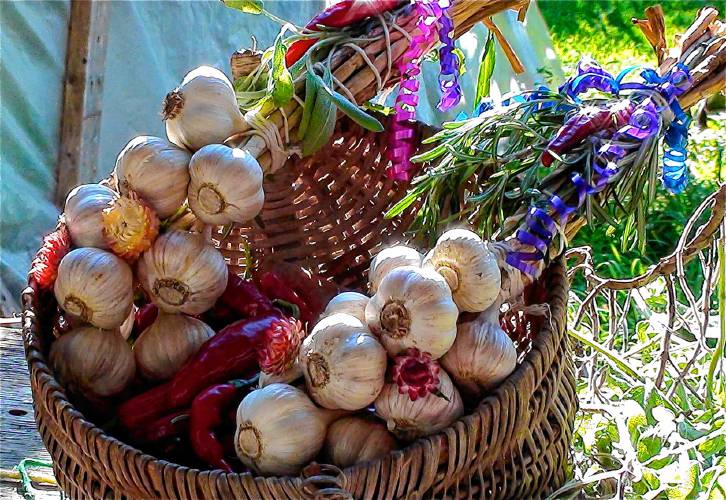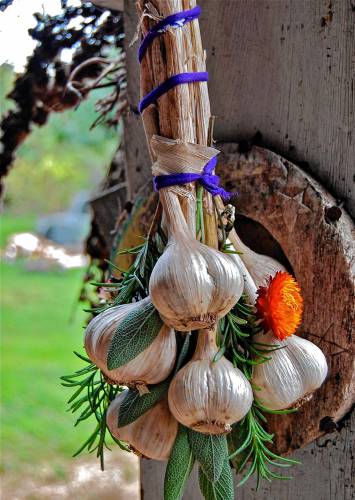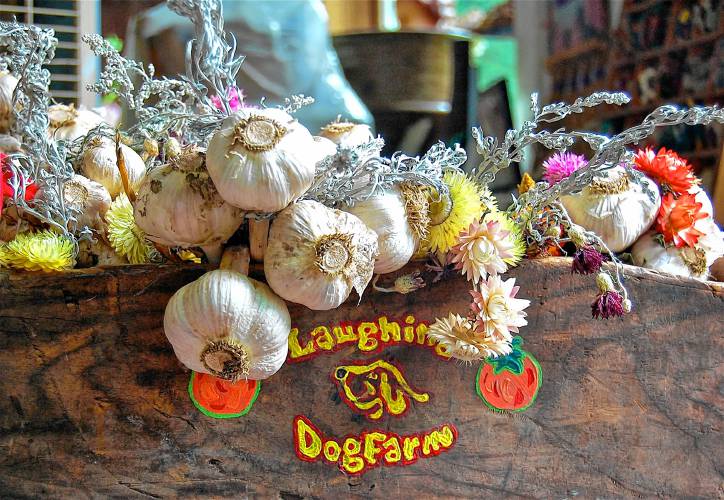‘Where would we be without garlic?’: Easiest-to-grow crop has scores of benefits, goes well in eggs and possibly even in socks
| Published: 10-30-2023 2:48 PM |
Last week, Recorder readers were treated to expert gardener Henry Homeyer’s tips for growing great garlic. Now I’ll explore the topic further, beginning with a vignette from 20 years ago.
On a sunny October afternoon in 2003, I planted 50 garlic cloves in my plot at the Pleasant Street Community Garden in Greenfield, already dreaming of the harvest to come. As I nudged cloves into the soil, I fervently hoped that — when I returned to reap fully formed heads the following July — I’d be accompanied by someone special.
I later harvested that garlic with my eight-week-old son nestled in a front-carrier. Wanting to move the crop, the baby, and myself out of the blazing sun, I dragged the pile of stalks to a shady spot and sat with my back against a tree trunk, nursing my infant. What had felt like an easy project in early pregnancy suddenly seemed a little overwhelming, so to give myself encouragement, I talked to my little guy.
“You’re too young to lend a hand this year, sweetheart, but when you’re bigger, you can help me hang garlic in the shed.” I explained to my seemingly oblivious child why we cure garlic in a spot that offers protection from both sunshine and moisture, and extolled the virtues of this special crop. I didn’t get much response, so I assumed Gillis had no idea what I was talking about, but maybe I was wrong.
Fast forward to 2023: last week, during dinner, garlic was once again the topic of conversation, but this time, it was Gillis who brought it up. Now six feet tall and 19 years old, he’s a part-owner of Real Pickles, the award-winning Greenfield business producing naturally fermented foods. “We processed about a ton today, Mom,” he said. “Garlic, garlic, all day long. I’m wiped.” Gillis wasn’t exaggerating when he said “about a ton,” and he described the process from start to finish.
“When a garlic delivery comes in, we have to determine the total weight,” said Gillis. “We pre-process it outdoors, because garlic just out of the ground is very dusty.” Using a deheading machine made up of two sets of rubber rollers that turn at different speeds, the Real Pickles crew gets busy. “Ours is an old machine, but it gets the job done,” said Gillis. Next comes the automatic peeler: “The center drum has sandpaper-like material, and water comes in the whole time. There’s a gap between the edge and the walls, so as the drum spins, skins fall off and slip out with the water.”
After that, the crew sorts cloves by hand, “removing remaining skins and anything that looks bad,” said Gillis. “If we can save over half the clove, we do. Otherwise, it goes in the compost. Lastly, the cloves get minced in a machine that’s kind of like a blender. Then we freeze anything we don’t need right away.”
I loved hearing my son delve so deeply into the topic, and wonder whether he might have taken in aspects of my 2003 garlic spiel after all, back when he was the size of a sourdough bread loaf? In any event, I offer proof that it’s good to involve children in gardening: this guy’s been a hard worker in agricultural realms since around the time his two-year molars were coming in. I highly recommend gardening as one of the finest forms of homeschooling.
Article continues after...
Yesterday's Most Read Articles
 Ja’Duke eyes expansion to Greenfield
Ja’Duke eyes expansion to Greenfield
 My Turn: Quabbin region will never see any benefits from reservoir
My Turn: Quabbin region will never see any benefits from reservoir
 The cool new ‘underground’ spot in town: Le Peacock in Shelburne Falls delivers on colorful décor, people, food and cocktails
The cool new ‘underground’ spot in town: Le Peacock in Shelburne Falls delivers on colorful décor, people, food and cocktails
 Renovation of vacant Greenfield house will help those ‘priced out’ of home ownership
Renovation of vacant Greenfield house will help those ‘priced out’ of home ownership
 Attorney seeks dismissal of RI man’s DUI charges in Northfield crash that injured seven
Attorney seeks dismissal of RI man’s DUI charges in Northfield crash that injured seven
 As I See It: Between Israel and Palestine: Which side should we be on, and why?
As I See It: Between Israel and Palestine: Which side should we be on, and why?
Local farmers and gardeners delight in sharing the joys of garlic. Another Real Pickles co-owner, Andy Van Assche, plants about 50 cloves each year on his Plainfield property. “When I harvest, I set aside the fattest cloves for the next crop,” said Van Assche, who uses garlic in cooking and also as preventative medicine, “just in case it really works.”
“I mince half a clove and swallow it quickly with OJ.” Marilyn Andrews, his late wife, chewed a raw clove every morning, swearing by it as a sore throat remedy and general tonic. “I tried that one time,” said Van Assche, “and it gave me serious dry heaves. So I wash it down as fast as I can.” When asked if his wife reeked of garlic round-the-clock, he answered, “Actually, she didn’t. I’m not sure why.”
Van Assche related a story about an acquaintance who put garlic slices in her socks. “She walked around on it all day, claiming that it went into her bloodstream,” he said. “That’s back when hippies used to make up crazy stuff.” Van Assche can be forgiven for questioning claims he heard in the 1970s. “For a time, whenever we were sick, Marilyn and I drank a brew made of nutritional yeast and milk. We read about it in some hippie nutritional book, which said to drink it every hour. But found that if we drank too much, our elbows and knees turned red.”
Having somehow survived that era, Van Assche chuckles about exploits at the Illinois commune where he and his wife lived for some years. “One time, a housemate took his turn at cooking and sprinkled multivitamins on the communal green salad. Little capsules and all. I’m lucky to be alive. Some of those claims weren’t backed up scientifically.”
Yet science may prove the garlic-in-the-socks practice to be effective. Substances on our skin can indeed make it inside our bodies; hence the warnings about using deodorants containing aluminum. Yet for most, it’s more fun to eat garlic, anyway, than to wear it. (Although, today being Halloween, you might want to adorn yourself, just in case vampires are lurking?)
WistyRorabacher and Judy Draper grow a lot of garlic and give it as gifts. Though they usually opt for local products, they’ve become enamored with garlic they order from Filaree Farm in Washington State. “It’s not elephant garlic,” said Rorabacher, referring to a type that’s both larger and milder than standard varieties. “It’s just really big, miraculous garlic.”
Draper came up with an idea for storing garlic: “I peel the cloves and freeze them in batches using former yogurt containers,” she said. “Then we pull whatever we need from the freezer and chop them up for cooking. The frozen garlic doesn’t get soft, and it’s absolutely delicious. I’ve never heard of anyone else doing it this way, but it works!”
They keep the rest of their crop in string bags, “down by the side door where it’s cool,” said Rorabacher. “We also love eating the scapes, earlier in the season. We put garlic in so many recipes, even in scrambled eggs.”
There are a number of ways to store harvested fresh garlic. Susie Patlove of Charlemont obtained her first batch from the late Terry Maloney, whose family started West County Cider in the mid-eighties. “I don’t exactly braid it, but it comes out looking that way,” said Patlove. “I cut the stalks off at about a foot long and wind a string around them, which looks so pretty. I start with three stalks, and keep adding in batches of three until I have about 30.” Patlove loves seeing the first shoots come up each spring. “I say, oh yeah, here we go again.”
Danny Botkin of Laughing Dog Farm in Gill is regionally known not only for seed saving, but also for spectacular garlic displays. “Before I started working with our longtime intern, Aaron Falbel, (partner DivyaShinn and I) just threw batches of cured garlic in a corner, but Aaron inspired us to get more creative. Now we include dried flowers and other decorations, even hot peppers.” Botkin snags inexpensive, colorful T-shirts from thrift stores and cuts them into strips, with which he binds garlic creations. He appreciates how growing garlic protects and leavens the soil. “And you can harvest it early enough in the season to make room for other crops.”
Due to his position as Acting Director of the Sunderland Public Library, Aaron Falbel no longer works with Botkin, but continues to grow garlic. He’s the impetus behind preserving and continuing the garlic legacy of the late Juanita Nelson, who was locally famous not only for farming methods, but also for remarkable work related to right livelihood, civil rights, land trusts, and peace activism. At the Nelson homestead in Deerfield, Falbel welcomes young visitors, from pre-teens to university students. While they work, Falbel shares philosophies and wisdom he learned from Wally and Juanita Nelson over many years.
Garlic is described by fans as miraculous, astounding, healthful, delicious and fun. To quote Gillis MacDougall, whose early exposure to the crop may have helped chart the course of at least one aspect of his life: “It’s good in almost everything. Where would we be without garlic?”
Eveline MacDougall is the author of “Fiery Hope,” and is a musician, artist and devoted garlic grower.





 Speaking of Nature: Indulging in eye candy: Finally, after such a long wait, it’s beginning to look like spring is here
Speaking of Nature: Indulging in eye candy: Finally, after such a long wait, it’s beginning to look like spring is here Celebrating ‘Seasonings’: New book by veteran preacher and poet, Allen ‘Mick’ Comstock
Celebrating ‘Seasonings’: New book by veteran preacher and poet, Allen ‘Mick’ Comstock Faith Matters: How to still the muddy waters of overthinking: Clarity, peace and God can be found in the quiet spaces
Faith Matters: How to still the muddy waters of overthinking: Clarity, peace and God can be found in the quiet spaces A time for every purpose under heaven: Free sing-a-long Pete Seeger Fest returns to Ashfield, April 6
A time for every purpose under heaven: Free sing-a-long Pete Seeger Fest returns to Ashfield, April 6
